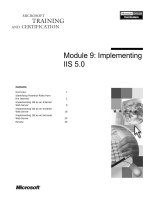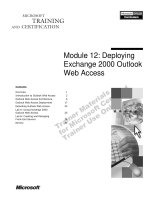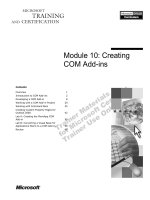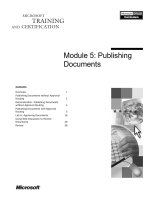Tài liệu Module 12: Summary docx
Bạn đang xem bản rút gọn của tài liệu. Xem và tải ngay bản đầy đủ của tài liệu tại đây (725.29 KB, 22 trang )
Contents
Overview 1
Design Patterns and Design Tools in Logical
Design 2
Technology Usage in Physical Design 7
Best Practices 13
Design Validation 14
Future Enhancements to Market Purchasing 17
Review 18
Module 12: Summary
Information in this document is subject to change without notice. The names of companies,
products, people, characters, and/or data mentioned herein are fictitious and are in no way intended
to represent any real individual, company, product, or event, unless otherwise noted. Complying
with all applicable copyright laws is the responsibility of the user. No part of this document may
be reproduced or transmitted in any form or by any means, electronic or mechanical, for any
purpose, without the express written permission of Microsoft Corporation. If, however, your only
means of access is electronic, permission to print one copy is hereby granted.
Microsoft may have patents, patent applications, trademarks, copyrights, or other intellectual
property rights covering subject matter in this document. Except as expressly provided in any
written license agreement from Microsoft, the furnishing of this document does not give you any
license to these patents, trademarks, copyrights, or other intellectual property.
2000 Microsoft Corporation. All rights reserved.
Microsoft, Active Directory, ActiveX, BackOffice, BizTalk, FrontPage, Microsoft Press, MSDN,
MS-DOS, PowerPoint, Visio, Visual Basic, Visual C++, Visual InterDev, Visual J++, Visual
Studio, Win32, Windows, and Windows NT are either registered trademarks or trademarks of
Microsoft Corporation in the U.S.A. and/or other countries.
Other product and company names mentioned herein may be the trademarks of their respective
owners.
Program Managers: Rhy Mednick, Susie Parrent
Instructional Designer: Susie Parrent
Subject Matter Experts: David Chesnut, Sam Gill (TechnoWiz), Michel Pahud
Media Management: David Mahlmann
Editing Manager: Lynette Skinner
Editor: Mick Alberts, Jennifer Linn
Production Manager: Miracle Davis
Print Coordinators: Linda Lu Cannon (Write Stuff), Marlene Lambert (Online Training
Solutions, Inc.)
Build Coordinator: Eric Wagoner
Graphic Artist: Scott Serna
Test Lead: Eric Myers
Manufacturing Manager: John Williams
Group Product Manager: Juan Fernando Rivera
Lead Product Manager, System Services and Infrastructure: Edward Dudenhoefer
Manufacturing Manager: Rick Terek
Operations Coordinator: John Williams
Manufacturing Support: Laura King; Kathy Hershey
Lead Product Manager, Release Management: Bo Galford
Group Manager, Courseware Infrastructure: David Bramble
General Manager: Robert Stewart
Module 12: Summary iii
Instructor Notes
This module provides students with a summary of the important logical and
physical design considerations for each of the layers in the Enterprise template.
After completing this module, students will be able to:
!
Summarize the logical design considerations for each of the layers of the
Enterprise template and in particular the use of design patterns.
!
Summarize the physical design considerations for each of the layers of the
Enterprise template and in particular the use of technology.
!
Review the key technologies that impact multiple layers.
!
Summarize the best practices for each of the layers of the Enterprise
template.
!
Discuss future enhancements for Market Purchasing.
Materials and Preparation
This section provides the materials and preparation tasks that you need to teach
this module.
Required Materials
To teach this module, you need the following materials:
!
Microsoft
®
PowerPoint
®
file 1910A_12.ppt
!
Module 12: Summary
Preparation Tasks
To prepare for this module, you should:
!
Read all of the materials for this module.
Presentation:
60 Minutes
Lab:
00 Minutes
iv Module 12: Summary
Module Strategy
Use the following strategy to present this module:
!
Design Patterns and Design Tools in Logical Design
The purpose of this section is to summarize the use of design patterns in the
logical design of the various layers of the architecture template. The review
is done by design pattern category.
In the topic “Creational,” note that there are no design patterns that are
useful.
In the topic “Structural,” note that there are three design patterns—Facade,
Composite, and Adapter—that are useful.
In the topic “Behavioral,” note that there are three design patterns—
Observer, Iterator, and State—that are useful.
In the topic “Other Patterns,” note that there are two design patterns—
Authenticate and Queue—that are useful. Also note that there are two
modeling techniques that are useful: metaphor and entity relationship
diagram (ERD).
!
Technology Usage in Physical Design
The purpose of this section is to summarize the use of technology in the
three main functions of an application: external interactions, business logic,
and state management. For each technology, a summary of its advantages
and disadvantages is presented. In addition, this section reviews two
technologies that are common to the physical design of all components:
security and error handling.
In the topic “External Interactions,” note that there are six technologies
reviewed: thin client, rich client, Message Queuing, Extensible Markup
Language (XML), distributed Component Object Model (DCOM), and
Simple Object Access Protocol (SOAP).
In the topic “Business Logic,” note that there is only one technology under
consideration: COM+.
In the topic “Data Store,” note that there are only two technologies under
consideration: Microsoft SQL Server
™
and Active Directory
™
.
!
Best Practices
The purpose of this section is to summarize the best practices for the logical
and physical designs of an application according to the various layers of the
Enterprise template.
!
Design Validation
The purpose of this section is to summarize the validation mechanisms for
logical and physical designs.
!
Future Enhancements to Market Purchasing
The purpose of this section is to emphasize that a good design must be
easily extensible and that the concept of extensibility can be tested by the
introduction of future enhancements to an application.
Module 12: Summary 1
#
##
#
Overview
!
Design Patterns and Design Tools in Logical Design
!
Technology Usage in Physical Design
!
Best Practices
!
Design Validation
!
Future Enhancements to Market Purchasing
This module presents a summary of the Enterprise template and highlights the
important logical and physical design considerations for each of the layers in
the Enterprise template.
After completing this module, you will be able to:
!
Summarize the logical design considerations for each one of the layers of
the Enterprise template and in particular the use of design patterns.
!
Summarize the physical design considerations for each one of the layers of
the Enterprise template and in particular the use of technology.
!
Review the key technologies that affect multiple layers.
!
Summarize the best practices for each of the layers of the Enterprise
template.
!
Discuss future enhancements for Market Purchasing.
Topic Objective
To provide an overview of
the module topics and
objectives.
Lead-in
In this module, you will
review a summary of the
material presented in this
course.
2 Module 12: Summary
#
##
#
Design Patterns and Design Tools in Logical Design
!
Creational
!
Structural
!
Behavioral
!
Other Patterns
The following review discusses how design patterns are used in architecture
templates, and in particular how patterns are used to design objects for the
various layers in these templates. The review is categorized by design pattern
type.
Topic Objective
To provide an overview of
the section topics and
objectives.
Lead-in
In this section, you will
review the use of design
patterns in the logical design
of an application.
Module 12: Summary 3
Creational
Design PatternLayer
NoneSystem Services
NoneData Services
NoneData Access Layer
NoneBusiness Logic
NoneFacade
NoneUser Services
The creational design patterns that are proposed by the book Design Patterns by
Erich Gamma, Richard Helm, Ralph Johnson, and John Vlissides, which
include Abstract Factory, Builder, Factory Method, Prototype, and Singleton,
were reviewed for their application to the various Enterprise template layers.
The conclusion drawn was that none of these design patterns are necessary
because the functionality that the design patterns provide is available through
either the operating system or component services.
The only design pattern that posed an issue is the Singleton. A Singleton
ensures that a class has only one instance and provides a global point of access
to it.
After careful consideration, the use of Singleton was rejected on the basis that it
was conceptually wrong to create a logical design that would restrict
concurrency.
Topic Objective
To provide a summary of
the use of creational design
patterns.
Lead-in
In this topic, you will see a
summary of the use of
creational design patterns in
the logical designs of
various architecture
template layers.
4 Module 12: Summary
Structural
Design PatternLayer
NoneSystem Services
NoneData Services
Composite
Adapter
Data Access Layer
CompositeBusiness Logic
FacadeFacade
NoneUser Services
There are eight structural design patterns in the Design Patterns book: Adapter,
Bridge, Composite, Decorator, Facade, Flyweight, and Proxy. Three have
proven to be useful in the logical design: Adapter, Composite, and Facade.
Unsurprisingly, the Facade pattern is the cornerstone for the Facade layer. As
discussed in detail in Module 5, “The Facade Layer,” the Facade pattern
provides for a common secure interface to the internals of an application. This
interface allows user services to become impervious to changes in the internal
structure of applications.
The Composite structural pattern is useful when an object such as a requisition
can contain several objects, such as line item details. Composite patterns are
useful in the business logic layer and in the data access layer (DAL).
Finally, the Adapter structural design pattern is useful in the logical design of
DAL objects that need to create uniform access to different types of data. Each
DAL component translates the underlying data store into a format suitable for
use in the rest of the system.
Topic Objective
To provide a summary of
the use of structural design
patterns.
Lead-in
In this topic, you will see a
summary of the use of
structural design patterns in
the logical designs of
various architecture
template layers.









